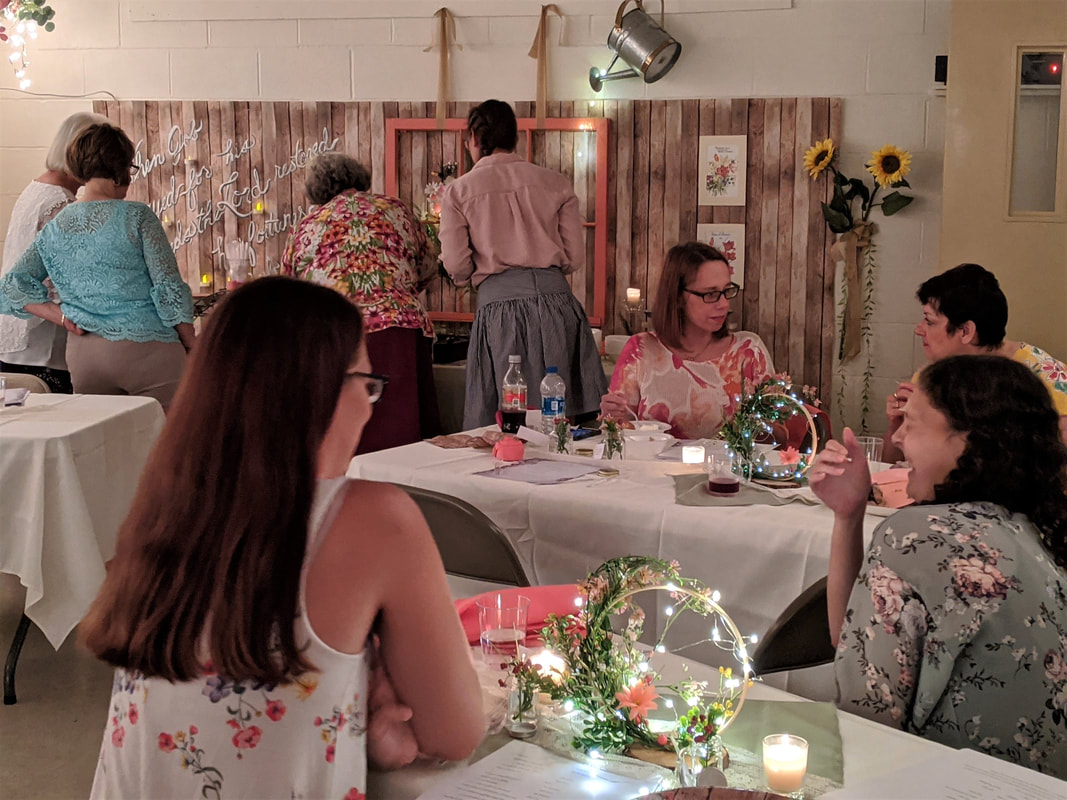|
Wildflower Tea August 11th 2020 Under the direction of Karla Myers, the basement was once again transformed into a beautiful tea room. This year, due to the pandemic, she and her team of planners were confronted with the added challenge of considering how to adjust the seating and serving arrangements. By placing fewer seats at larger tables, extra space was provided without destroying the friendly atmosphere. Plastic gloves were available at the head of the serving table. Several ladies spent Saturday and/or Monday at the church. The hours setting up tables, hanging decorations, folding napkins, etc. were well spent. Conversation sweetened the work, and many hands made the load lighter. Maurina served the ladies by planning the menu. The recipes were easy to follow, and the dishes were pretty and packed with flavor. Bonnie’s Hibiscus tea was refreshing, especially at the end of a hot and humid August evening. Friendship was the theme of the program. Most of the ladies contributed by reading selected quotations. Julie and Jacquie sang an arrangement of the hymn, “Fairest Lord Jesus”. Our special speaker was Joie Fitzpatrick, who spoke to us about the Best Friend, Jesus Christ. She reminded us that he is our Familiar, Faithful & Forgiving friend who desires our Fellowship. We were challenged to find Christ’s counsel for our good and our growth in His word. We need to read, to love, to listen, and to hide His word in our hearts. It will teach, help, encourage, chide, correct, and show us our need of repentance, as well as reveal the glory of His grace. Bonnie closed the meeting by thanking the ladies and inviting all to join the church group as they plan to begin a Bible study on subject of Joy this September.
0 Comments
The priests were to be clothed in a special way. They were clothed for glory and beauty because they were the servants in the house of God. Their clothing was in that sense livery, such as the servants of a great house wear, marking them out, signaling the dignity of their employer. The priestly garments were expensive clothes.
The main garment was called an ephod, which was an apron-like garment of costly material. On the shoulders of the ephod were onyx stones, each with six of the names of the tribes of Israel. The meaning is that the high priest who wore this garment carried the people on his shoulders. That was a priestly function: to represent the people before God. Resting on the ephod and attached to it carefully was a pouch with a metal plate on the front called the breastplate. This golden plate had twelve different jewels set on it: four across and three down. These once again were engraved with the names of the twelve tribes, so that the priest had them on his heart. The point again is that he is their representative before God. Under the ephod was a blue, sleeveless tunic, which had a hem bordered with yarn balls shaped like pomegranates alternating with metal bells. There are two things to observe here. One is the theme of trees and fruit that you get in the decorations of the Tabernacle and see emphasized more in the Temple. There is the suggestion of a garden, the garden, in fact, of Eden. Where did God come to walk with Adam before sin broke the relationship? It was in a garden, and the priest represents a return to that. What is the meaning of the bell? When the priest was doing his work in the tent, nobody saw him. Only priests could go in, and there was a section, the Holy of Holies, where nobody except the high priest could go. The bells, however, sounded as he went about his business: he could be heard though he could not be seen. The sound of a priest doing efficacious work in God's presence on behalf of God's people is the sound of the Gospel. The Gospel after all is a report of a transaction Jesus Christ our high priest has conducted on our behalf in God's presence, a report that he still intercedes for us in a place we can't see, and a promise of better access to God than the old covenant afforded. The text says that the bell had to sound so that Aaron might not die. That is why I think it represents the Gospel, the sound of the promise of the Gospel, the actual efficacious transaction without which nobody can live. On the high priest's head was a turban, and surmounting the turban was a plate of gold in which was engraved "Holiness to the Lord." In connection with this garment we read that Aaron would bear any guilt from the holy things that the people consecrated. Having the engraved plate on his forehead, the gifts would be accepted. It is a constant reminder that the people brought contamination, uncleanness, and that which was unholy to God in whose presence everything must be made holy, fitting for him. God established a Tabernacle so that by means of these shadows and symbols they could have access to him. It was a limited access, but it was real access because it was a shadow and symbol of Jesus Christ, who really is holy, who really makes us clean, and who bears away our guilt. |
AuthorVarious Archives
August 2023
Categories
All
|

 RSS Feed
RSS Feed